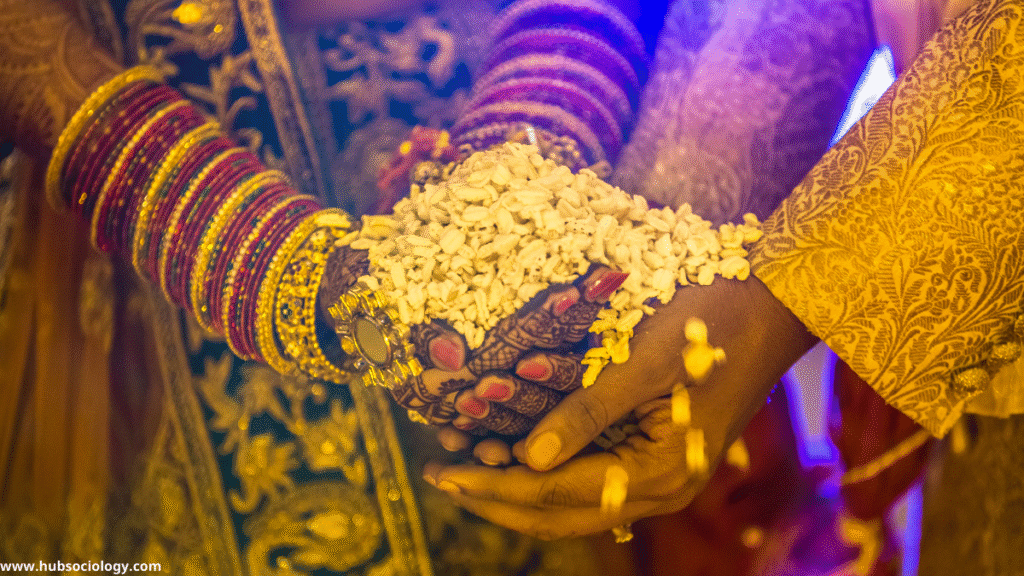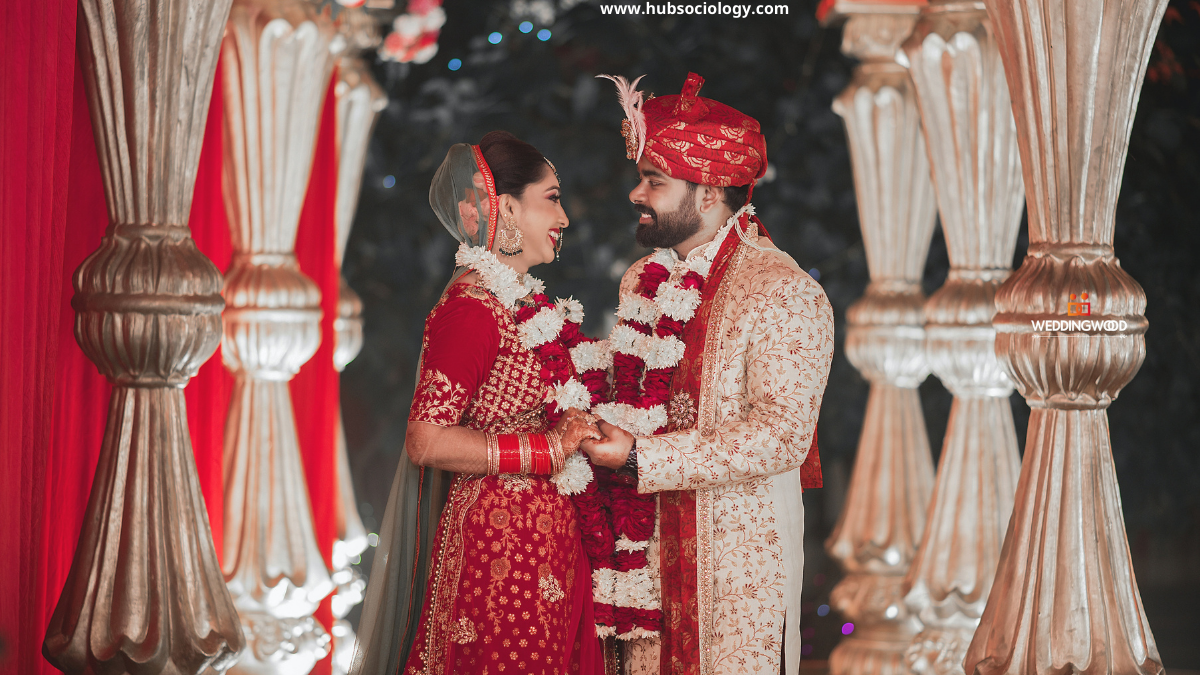Introduction on Marriage among Hindus
In India, marriage is far more than a mere legal contract or a romantic union between two individuals. For Hindus, who constitute the majority of the country’s population, marriage is a profound sanskara (sacrament), a pivotal religious duty, and a fundamental building block of the social order. To understand Marriage among Hindus through a sociological lens is to delve into a complex institution where sacred scriptures intersect with modern aspirations, and ancient norms are constantly negotiated within contemporary realities. Kinship, caste, class, and gender roles are among the fundamental pillars of Indian culture that are reflected and upheld by this vibrant institution.
Table of Contents on Marriage among Hindus
The Foundation: Dharma, Caste and Kinship
At its core, traditional Hindu marriage is deeply embedded in the concept of dharma—righteous duty. For many, it is not primarily for personal fulfillment but for fulfilling obligations to family, community, and gods. It permits the legal reproduction of sons, who are customarily tasked with carrying out the burial ceremonies (shraddha) to guarantee their parents’ souls are saved, and it guarantees the continuity of the patrilineal lineage (gotra).

The most significant sociological filter governing Hindu marriage is the caste system. The principle of endogamy—marrying within one’s own caste or sub-caste (jati)—has been, and in many communities remains, the non-negotiable rule. This practice reinforces caste boundaries, maintains ritual purity, and preserves social and economic capital within specific groups. While the legal framework, through the Hindu Marriage Act (1955), prohibits discrimination based on caste, social sanction and the threat of ostracization often overpower the law. Marriages that transgress caste lines, known as inter-caste marriages,, though increasing in urban areas, still face significant social resistance and sometimes even violence, highlighting the enduring power of this social hierarchy.
Alongside caste, the rules of exogamy also apply. The prohibition on marrying within one’s gotra (a clan tracing descent from a common mythical ancestor) and pravara (a narrower lineage within the gotra) is a near-universal rule aimed at preventing incest and broadening kinship alliances. This intricate web of rules—marry within your caste but outside your gotra—showcases how marriage is strategically used to forge and maintain social networks.
The Changing Landscape: From Arranged to “Assisted” Marriages
One of the most important areas of sociological research is the spouse selection process. The traditional “arranged marriage,” in which parents or elders choose a spouse with little to no involvement from the parties, has changed dramatically.
- The Traditional Arranged Marriage: This model was the norm, based on considerations of caste, economic status, horoscope compatibility (kundali milan), and family reputation. It was an alliance between two families rather than two individuals, emphasizing duty, compatibility of values, and social stability over romantic love.
- The “Arranged-Love” Marriage Spectrum: Today, a hybrid model dominates. These days, “arranged-love marriages” and “aided marriages” are prevalent, particularly in middle-class, educated, and metropolitan households. Here, parents and relatives act as facilitators, using their social networks and, increasingly, online matrimonial portals to find potential matches. However, following a period of interaction, the prospective couple usually makes the final decision. This shift reflects the growing influence of Western ideals of individualism and companionate marriage, balancing personal choice with familial approval.
The procedure has become more digital and commercialized with the rise of marriage services such as Shaadi.com and Jeevansathi.com. Profiles are curated to highlight caste, sub-caste, education, income, skin tone, and dietary habits, demonstrating how modern technology is being used to perpetuate traditional social markers.
The Institution and Its Discontents: Gender, Dowry, and Power
A sociological analysis of Marriage among Hindus cannot ignore its patriarchal underpinnings. Traditionally, marriage has been a key institution for the transfer of patrilocal residence (the wife moves into the husband’s household), and the control of female sexuality.

The custom of kanyadaan, or the father giving the daughter as a gift, represents the handover of power and duty from the bride’s father to the groom. While religiously sanctified, sociologically it frames the woman as a gift to be given away, establishing her dependent status in her new family.
This inequality is starkly evident in the persistent evil of dowry (dahej). Despite being illegal since 1961, the dowry system remains rampant. It entails the bride’s family transferring money, assets, or property to the groom’s family. Far from being a simple custom, it is a potent instrument of patriarchy and economic transaction. It reflects and reinforces the lower status of women, treating them as a financial burden. It can also lead to horrific consequences, including dowry harassment and dowry deaths, where brides are murdered or driven to suicide for bringing insufficient dowry.
Furthermore, the prescribed gender roles within a marriage are often rigid. Pativrata, or chaste, dedicated to her husband, and the head of the household, is the ideal Hindu wife. The husband is the primary breadwinner and the head of the household. While educated, working women are increasingly common, they often face the “double burden” of professional responsibilities and the unchanging expectations of domestic duty and caregiving.
Modernity and Change: Negotiating New Realities
Globalization, urbanization, education, and economic liberalization are powerful forces reshaping the sociology of Marriage among Hindus.
- Rising Age of Marriage: As educational and career opportunities for women expand, the average age of marriage is rising, allowing for greater individual autonomy and maturity before entering the institution.
- Inter-caste and Love Marriages: While still a minority, these marriages are becoming more visible, particularly in metropolitan areas, challenging deep-seated social prejudices.
- Legal Reforms and Individual Rights: Laws have provided women with greater rights concerning divorce, inheritance, and protection from domestic violence. The very concept of divorce, once a tremendous social taboo, is now more accepted, indicating a shift where personal happiness is beginning to rival the notion of duty and sacrifice.
- Re-defining Relationships: Concepts like live-in relationships, though still controversial, are entering the urban social lexicon, presenting an alternative to formal marriage.
Conclusion on Marriage among Hindus
Marriage among Hindus in India is a living, breathing institution in a state of constant flux. It is a fascinating sociological subject precisely because it exists at a crossroads. It is simultaneously a sacred sacrament, a strategic alliance, an economic transaction, and, increasingly, a quest for companionship. While the forces of modernity—individualism, education, and legal rights—are slowly eroding its traditional foundations, the core structures of caste, kinship, and patriarchy demonstrate remarkable resilience.

The modern Hindu marriage is thus a site of negotiation, where ancient dharma is continually being reinterpreted to accommodate contemporary aspirations, creating a complex and evolving tapestry that is uniquely Indian.
Do you like this this Article ? You Can follow as on :-
Facebook – https://www.facebook.com/hubsociology
Whatsapp Channel – https://whatsapp.com/channel/0029Vb6D8vGKWEKpJpu5QP0O
Gmail – hubsociology@gmail.com
Topic Related Questions on Marriage among Hindus
5 Marks Questions on Marriage among Hindus (Short Answer)
- Define Hindu marriage as a sacrament (sanskara). Explain two of its characteristics.
- Briefly explain the concepts of endogamy and exogamy in the context of Hindu marriage.
- What is the role of the caste system in regulating traditional Hindu marriages?
- How has the process of arranged marriage changed in urban India? Describe briefly.
- List any five traditional rituals in a Hindu wedding and state their sociological significance.
- What is meant by the rule of gotra exogamy? Why is it practiced?
- Briefly explain the term “dowry” and state one reason for its persistence in modern times.
- How does the ritual of Kanyadaan reflect the patriarchal nature of traditional Hindu society?
- Differentiate between arranged marriage and love marriage from a sociological standpoint.
- What is the impact of education on the age and choice of partner in Hindu marriage?
10 Marks Questions on Marriage among Hindus (Detailed Answer)
- Discuss Hindu marriage as a sacrament (sanskara) and a contract. How are these two aspects reconciled in modern times?
- Analyze the role of caste and kinship in determining the structure of Hindu marriage.
- “The institution of dowry is a social evil that perpetuates gender inequality.” Discuss this statement in the context of Hindu marriage.
- Examine the changing trends in spouse selection from arranged marriages to assisted and love marriages. What factors are driving this change?
- Critically analyze the patriarchal norms embedded in the rituals and practices of a traditional Hindu wedding.
- How has legislation like the Hindu Marriage Act (1955) and the Dowry Prohibition Act (1961) impacted the institution of marriage?
- Discuss the concept of sapinda and gotra exogamy. Why are these rules considered important in traditional Hindu law and society?
- Evaluate the influence of modernization and globalization on the stability and form of the Hindu family structure.
- What are the emerging trends in Hindu marriages in metropolitan cities? Discuss with reference to changing gender roles.
- Analyze the interplay between individual choice and family authority in the process of mate selection among Hindus in India.
15 Marks Questions on Marriage among Hindus (Essay-type / Comprehensive Answer)
- Elaborate on the sociological perspectives (functionalist, conflict, and symbolic interactionist) to understand the institution of Hindu marriage in India.
- “Hindu marriage is a complex institution caught between the traditional ideals of dharma and the modern ideals of companionship.” Critically examine this statement.
- Discuss the various forms of marriage prescribed in ancient Hindu texts. How do they compare to the prevalent monogamous form of marriage today?
- Analyze the changing status of women within Hindu marriage, focusing on aspects like education, employment, decision-making power, and divorce.
- How do factors like urbanization, rise of the middle class, and the IT sector influence the patterns and practices of marriage among Hindus?
- Examine the persistence of the caste system in Hindu matrimonial practices despite legal prohibitions. What does this reveal about the nature of social change in India?
- Discuss the institution of Hindu marriage as a mechanism for the reproduction of social structure, including caste, class, and patriarchy.
- “Matrimonial websites have commercialized and modernized the process of arranged marriage without fundamentally challenging its core principles.” Discuss.
- Critically evaluate the impact of religious revivalism and reform movements on the practices and laws related to Hindu marriage in contemporary India.
- Compare and contrast the ideals and realities of Hindu marriage in rural and urban settings in India.
